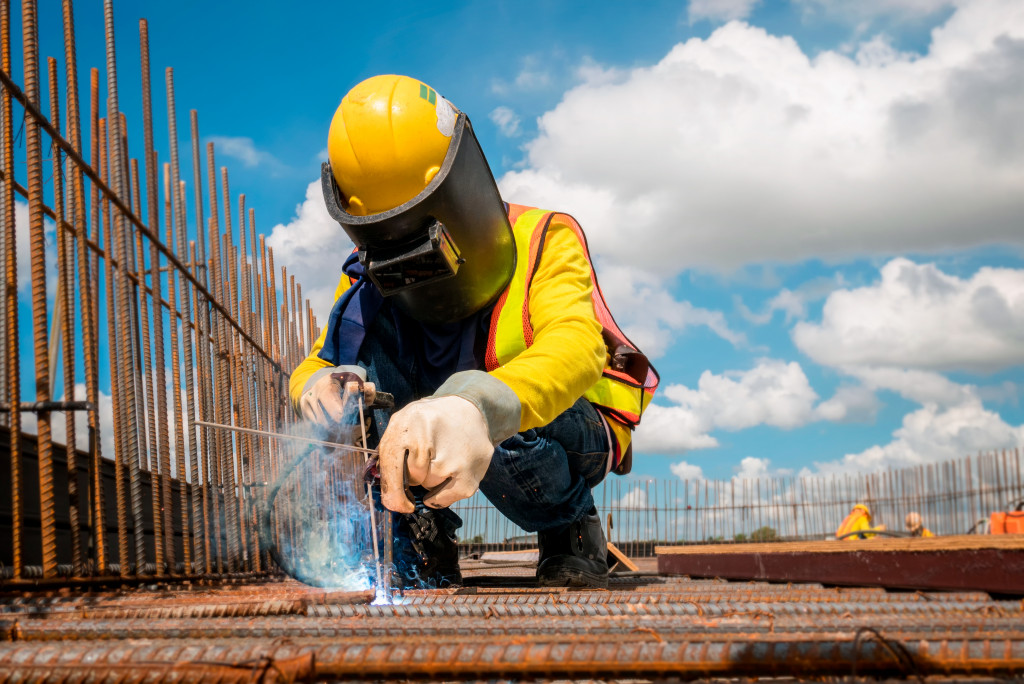- The right tools are essential to a successful construction project, as they increase efficiency and improve site safety.
- Investing in high-quality tools pays off in the long run, as it can provide a competitive advantage.
- Tool organization and maintenance are essential for efficiency and safety; workers should have designated places for each tool.
- Safety precautions such as guards, safety switches, and personal protective equipment must always be used when working with tools.
- Essential hand tools, measuring and marking tools, cutting and shaping tools, chain slings, and power tools are necessary for construction.
When it comes to construction work, having the right tools at your disposal is vital to ensure you can get the job done efficiently and safely. Whether a minor renovation or a large-scale development project, having the right tools will help you achieve your goals in record time.
Every construction worker knows that having the right tools is essential to the success of any project. With the right tools, work can become manageable, which can lead to delays, mistakes, and accidents. Investing in high-quality tools may seem like an added expense, but it is an investment that can pay off hugely in the long run.
This article will explore the importance of having the right tools in construction, the benefits they bring to on-site productivity, and how to organize and maintain them properly for improved efficiency and safety.
Benefits of Having the Right Tools
Construction sites are dynamic places that require coordination, safety, and efficiency. To achieve these objectives, workers need the right tools.
Adequately equipped construction workers are more productive, work faster, and create higher-quality structures. Here are some essential hand, measuring and marking, cutting and shaping, fastening, and power tools.
Increased Efficiency
One of the key benefits of having the right tools is increased efficiency. With the right tools, workers can complete tasks faster and more accurately. For example, using power tools such as drills, saws, and nail guns can save significant time which would have been spent doing the same job manually.
This increased efficiency allows more work to be done in less time, ultimately increasing productivity and profits.
Enhanced Quality of Work
Having the right tools improves productivity and enhances the quality of work. Using precise tools, workers can produce higher-quality finished products requiring less rework.
For example, a laser level can ensure that walls are straight and level, resulting in a more professional and polished finished product. This better quality of work can help construction companies to establish a reputation for excellence and attract more clients.
Improved Safety
In construction, safety is critical. The right tools can help keep workers safe on the job site. Power tools such as circular saws, drills, and angle grinders can be dangerous if not handled carefully.
Still, workers can significantly reduce the risk of accidents and injuries by using safety features such as guards, safety switches, and personal protective equipment. Investing in high-quality protective equipment such as helmets, gloves, glasses, and boots is essential to creating a safe work environment.
Competitive Advantage
The right tools can also provide a competitive advantage in the construction industry. Companies that invest in high-quality tools and equipment can produce better quality work faster and more efficiently than their competition. This can give them an edge in securing new clients and bids.

Tool Organization and Safety
While having the right tools is essential, it is also critical to organize and maintain them for maximum efficiency and safety. Proper organization and maintenance can help extend the life of your tools and improve job site safety.
Importance of Tool Organization for Efficiency
Tool organization can be a critical factor in on-site efficiency. Whether it’s a toolbox or a larger storage unit, having a designated place for each tool is essential.
This keeps tools organized and easily accessible, reducing the time spent searching for the right tool in the middle of a job. When tools are well-organized, workers can focus on the task at hand, which helps to increase productivity.
Proper Tool Maintenance and Storage
Proper maintenance and storage of tools are critical for tool longevity. Keeping tools clean, dry, and adequately lubricated can help extend their life and ensure they work correctly.
A regular maintenance schedule should be implemented to ensure that tools are maintained and stored correctly after use.
Safety Precautions and Protective Equipment
Finally, the safety of workers should always be a top priority. Proper safety procedures and personal protective equipment must always be used when working with tools.
Before using a tool, workers should ensure it is in good working order and equipped with all necessary safety features. Personal protective equipment such as helmets, gloves, glasses, and boots should always be worn when working with power tools.
Essential Hand Tools
Hand tools are the most common construction tools. These include screwdrivers, hammers, pliers, wrenches, chisels, and many others.
A dependable hand tool enables a worker to do a job better and faster. At the same time, an inferior tool requires more effort, leading to productivity loss. Hence, equipping workers with top-notch hand tools is cost-effective.
Measuring and Marking Tools
These include levels, tape measures, squares, and laser tools. They help measure distances and spaces, allowing the cutting and shaping of materials with precision. Accurate measurements prevent inaccurate cuts, reducing material damage and the need for replacements.
Cutting building materials with precision increases their lifespan, adds to the building’s stability, and saves the company costs in the long term.
Cutting and Shaping Tools
Saws, chisels, snips, and pliers are handy in cutting and shaping building materials. Using the wrong tool leads to jagged edges and cracks, making materials weaker and less durable. Correct cutting and shaping tools achieve precision, higher-quality finishes, and reduced material costs.
Fastening Tools
These include clamps, pliers, nail guns, and screwdrivers. They connect building materials and are invaluable for creating stable structures. Correctly fastened materials create strong structures that are safe and sturdy. Using the wrong or damaged fastening tool risks the stability of the structure, leading to injury and collapse.
Chain Sling
A high-quality chain sling helps attach heavy materials to cranes. They are solid and flexible and can transport heavy loads safely. A chain sling that is too thin or has the wrong material increases the risk of collapse, leading to catastrophic accidents.
Power Tools
Power tools use electric motors or petrol engines to generate movement rather than manual labor. They include angle grinders, power drills, cut-off saws, and air compressors.
Power tools offer speed, strength, and precision, reducing the workload and increasing productivity. Operators should be well-versed with the safety measures required when using power tools.

Having the right tools is essential in construction work. It helps enhance productivity, improve work quality, improve job site safety, and provide a competitive advantage.
Proper organization, maintenance, and safety practices can maximize tool efficiency and longevity and keep workers safe. So, whether you’re a seasoned professional or a DIY enthusiast, remember that investing in high-quality tools is a sound investment that will pay off in the long run.



